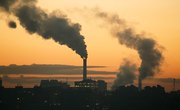
Carbon dioxide is among the many scientific terms that carries a wide range of meanings and a similarly broad array of connotations. If you're familiar with cellular respiration, you may know that carbon dioxide gas – abbreviated CO2 – is a waste product of this series of reactions in animals, in which oxygen gas, or O2, is a reactant; you may also know that in plants, this process is in effect reversed, with CO2 serving as a fuel in photosynthesis and O2 as a waste product.
Perhaps more famously, thanks to the politics and Earth science of the current century, CO2 is notorious for being a greenhouse gas, responsible for helping to trap heat in the Earth's atmosphere. CO2 is a by-product of the burning of fossil fuels, and the consequent warming of the planet has led citizens of Earth on a quest for alternative sources of energy.
Apart from these issues, CO2 gas, an elegantly simple molecule, has a number of other biochemical and industrial functions that science fans should be aware of.
What Is Carbon Dioxide?
Carbon dioxide is a colorless, odorless gas at room temperature. Every time you exhale, carbon dioxide molecules leave your body and become part of the atmosphere. CO2 molecules contains a single carbon atom flanked by two oxygen atoms, such that the molecule is linear in shape:
O=C=O
Each carbon atom forms four bonds with its neighbors in stable molecules, while each oxygen atom forms two bonds. Thus with each carbon-oxygen bond in CO2 consisting of a double bond – that is, two pairs of shared electrons – CO2 is highly stable.
As a glance at a periodic table of elements reveals (see Resources), the molecular weight of carbon is 12 atomic mass units (amu), while that of oxygen is 16 amu. The molecular weight of carbon dioxide is thus 12 + 2(16) = 44. Another way to express this is to say that one mole of CO2 has a mass of 44, with one mole being equivalent to 6.02 × 1023 individual molecules. (This figure, known as Avogadro's number, is derived from the fact that the molecular mass of carbon is set at exactly 12 grams, which us twice the number of protons carbon contains, and this mass of carbon contains 6.02 × 1023 carbon atoms. The molecular weight of every other element was structured around this standard.)
Carbon dioxide can also exist as a liquid, a state in which is is used as a refrigerant, in fire extinguishers and in the production of carbonated beverages such as soda; and as a solid, in which state it is used as a refrigerant and may cause frostbite if it comes into contact with skin.
Carbon Dioxide in Metabolism
Carbon dioxide is often misunderstood as being toxic because it is frequently associated with asphyxiation and even loss of life. While sufficient levels of CO2 can in fact be directly toxic and cause asphyxiation, what usually happens is that CO2 instead builds up as a result or consequence of asphyxiation. If someone stops breathing for any reason, CO2 is no longer expelled through the lungs, and therefore builds up in the bloodstream as it has nowhere else to go. CO2 is therefore a marker of asphyxiation. In roughly the same way, water is not "toxic" merely because it can lead to drowning.
Only a tiny fraction of the atmosphere consists of CO2 – about 1 percent. While it is a by-product of animal metabolism, it is absolutely necessary for plants to survive and is an instrumental part of the worldwide carbon cycle. Plants take in CO2, convert it in a series of reactions carbon and oxygen, and then release the oxygen to the atmosphere while retaining the carbon in the form of glucose to live and grow. When plants die or are burned, their carbon recombines with O2 in the air, forming CO2 and completing the carbon cycle.
Animals generate carbon dioxide through the breakdown of ingested carbohydrates, proteins and fats in food. All of these are metabolized to glucose, a six-carbon molecule that then enters cells and ultimately becomes carbon dioxide and water, with the resulting energy used to power cellular activities. This occurs through the process of aerobic respiration (often called cellular respiration, although the terms are not precisely synonymous). All glucose that enters the cells of both prokaryotes (bacteria) and non-plant eukaryotes (animals and fungi) first undergoes glycolysis, which generates a pair of three-carbon molecules called pyruvate. Most of this enters the Krebs cycle in the form of the two-carbon molecule acetyl CoA, while CO2 is liberated. The high-energy electron carriers NADH and FADH2 that are formed during the Krebs cycle then give up electrons in the presence of oxygen in the electron transport chain reactions, resulting in the formation of a great deal of ATP, the "energy currency" of the cells of living things.
Carbon Dioxide and Climate Change
CO2 is a heat-trapping gas. In many respects, this is a good thing, as it prevents the Earth from losing so much heat that animals such as people would be unable to survive. But the combustion of fossil fuels since the onset of the Industrial Revolution in the 19th century has added a significant amount of CO2 gas to the atmosphere, leading to global warming and its gradually worsening effects.
For many thousands of years, the atmospheric concentration of CO2 in the atmosphere remained between 200 and 300 parts per million (ppm). By 2017, it had risen to nearly 400 ppm, a concentration that is still increasing. This extra CO2 is trapping heat and causing the climate to change. This is manifested not only in rising average temperatures worldwide, but in rising sea levels, glacial melts, more acidic sea water, smaller polar ice caps and an uptick in the number of catastrophic events (for example, hurricanes). These problems are all interrelated and interdependent.
Examples of fossil fuels include coal, petroleum (oil) and natural gas. These are created over a period of millions of years as dead plant and animal material becomes trapped and buried under layers of rock. Under favorable heat and pressure conditions, this organic matter is transformed into a fuel. All fossil fuels contain carbon, and these are burned to yield energy, and carbon dioxide is released.
Uses of CO2 in Industry
Carbon dioxide gas has a variety of uses, which is handy because the stuff is literally everywhere. As noted previously, it is used as a refrigerant, though this is more true of the solid and liquid forms. It is also used as an aerosol propellant, a rodenticide (i.e., rat poison), a component of very low-temperature physics experiments and an enriching agent in the air inside greenhouses. It is also put to use in the fracturing of oil wells, in some types of mining, as moderator in certain nuclear reactors and in special lasers.
Interesting fact: Through basic metabolic processes, you will produce about 500 grams of CO2 in the next 24 hours – even more if you're active. That is more than one pound of invisible gas, just wafting out of your nose and mouth as well as from your pores. This, in fact, is how people lose weight over time, not including water (temporary) losses.
References
- National Center for Biotechnology Information: Carbon Dioxide
- United States Environmental Protection Agency: Getting to the Core: The Link Between Temperature and Carbon Dioxide
- Scientific American: If Carbon Dioxide Makes up Only a Minute Portion of the Atmosphere, How Can Global Warming Be Traced to It?
About the Author
Kevin Beck holds a bachelor's degree in physics with minors in math and chemistry from the University of Vermont. Formerly with ScienceBlogs.com and the editor of "Run Strong," he has written for Runner's World, Men's Fitness, Competitor, and a variety of other publications. More about Kevin and links to his professional work can be found at www.kemibe.com.
